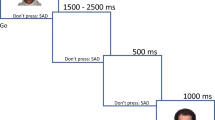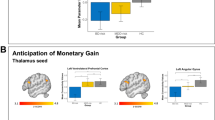Abstract
Major depressive disorder aggregates within families, although the mechanisms of transfer across generations are not well understood. In light of converging biological and behavioral evidence that depressive symptoms are associated with impaired reward processing, we examined whether adolescent girls with a parental history of depression would also exhibit abnormal reward sensitivity. We performed a negative mood induction and then recorded the feedback negativity, a neural index of reward processing, while individuals completed a gambling task. High-risk adolescents reported greater sadness following the mood induction compared to low-risk adolescents. Among the high-risk group, sadness was strongly associated with a blunted feedback negativity, even after controlling for baseline mood and trait neuroticism. This suggests that high-risk adolescents are more reactive to negative stimuli, which significantly alter neural sensitivity to monetary gains and losses. The feedback negativity might be used to identify information processing abnormalities in high-risk populations prior to the onset of a major depressive episode.




Similar content being viewed by others
Notes
As a point of comparison, we repeated then regression analysis using sadness as a difference score, post-induction minus baseline, rather than covariation. The pattern of results was similar, with sadness change inversely related to FN amplitude across the whole sample at the bivariate level (r = 0.28, p < 0.01) and after adjusting for risk status, neuroticism, and depressive symptoms (β = 0.31, p < 0.01). This association was again stronger among the high-risk group (r = 0.51, p < 0.01) compared to the low-risk group (r = 0.31, p < 0.05), although the difference between the correlation coefficients was less pronounced and the interaction term was not statistically significant (β = 0.11, p = 0.33).
References
Arnett, J. J. (1999). Adolescent storm and stress, reconsidered. The American Psychologist, 54(5), 317–326.
Bellebaum, C., Polezzi, D., & Daum, I. (2010). It is less than you expected: the feedback-related negativity reflects violations of reward magnitude expectations. Neuropsychologia, 48(11), 3343–3350.
Cannon, D. S., Tiffany, S. T., Coon, H., Scholand, M. B., McMahon, W. M., & Leppert, M. F. (2007). The PHQ-9 as a brief assessment of lifetime major depression. Psychological Assessment, 19(2), 247–251.
Cohen, P. R. (1988). The effects of instruments and informants on ascertainment. In D. L. Dunner, E. S. Gershon, & J. E. Barrett (Eds.), Relatives at risk for mental disorders (pp. 32–51). New York: Raven Press.
Davidson, R. J. (1998). Affective style and affective disorders: perspectives from affective neuroscience. Cognition and Emotion, 12(3), 307–330.
Debener, S., Beauducel, A., Nessler, D., Brocke, B., Heilemann, H., & Kayser, J. (2000). Is resting anterior EEG alpha asymmetry a trait marker for depression? Findings for healthy adults and clinically depressed patients. Neuropsychobiology, 41(1), 31–37.
Duggan, C., Sham, P., Lee, A., Minne, C., & Murray, R. (1995). Neuroticism: a vulnerability marker for depression evidence from a family study. Journal of Affective Disorders, 35(3), 139–143.
Dunning, J. P., & Hajcak, G. (2007). Error-related negativities elicited by monetary loss and cues that predict loss. Neuroreport, 18(17), 1875–1878.
Field, T., Fox, N. A., Pickens, J., & Nawrocki, T. (1995). Relative right frontal EEG activation in 3- to 6-month-old infants of depressed mothers. Developmental Psychology, 31, 358–363.
Forbes, E. E. (2009). Where’s the fun in that? Broadening the focus on reward function in depression. Biological Psychiatry, 66(3), 199–200.
Forbes, E. E., Shaw, D. S., & Dahl, R. E. (2007). Alterations in reward-related decision making in boys with recent and future depression. Biological Psychiatry, 61(5), 633–639.
Foti, D., & Hajcak, G. (2009). Depression and reduced sensitivity to non-rewards versus rewards: evidence from event-related potentials. Biological Psychology, 81(1), 1–8.
Foti, D., & Hajcak, G. (2010). State sadness reduces neural sensitivity to non-rewards versus rewards. Neuroreport, 21(2), 143–147.
Foti, D., Weinberg, A., Dien, J., & Hajcak, G. (2011). Event-related potential activity in the basal ganglia differentiates rewards from non-rewards: temporospatial principal components analysis and source localization of the feedback negativity. Human Brain Mapping.
Gehring, W. J., & Willoughby, A. R. (2002). The medial frontal cortex and the rapid processing of monetary gains and losses. Science, 295(5563), 2279–2282.
Goodman, S. H. (2007). Depression in mothers. Annual Review of Clinical Psychology, 3, 107–135.
Gratton, G., Coles, M. G., & Donchin, E. (1983). A new method for off-line removal of ocular artifact. Electroencephalography and Clinical Neurophysiology, 55(4), 468–484.
Grubbs, F. (1969). Procedures for detecting outlying observations in samples. Technometrics, 11(1), 1–21.
Hajcak, G., Moser, J. S., Holroyd, C. B., & Simons, R. F. (2006). The feedback-related negativity reflects the binary evaluation of good versus bad outcomes. Biological Psychology, 71(2), 148–154.
Hajcak, G., Moser, J. S., Holroyd, C. B., & Simons, R. F. (2007). It’s worse than you thought: the feedback negativity and violations of reward prediction in gambling tasks. Psychophysiology, 44(6), 905–912.
Hammen, C. L. (2009). Children of depressed parents. In I. H. Gotlib & C. L. Hammen (Eds.), Handbook of depression (2nd ed., pp. 275–297). New York: Guilford Press.
Henriques, J. B., & Davidson, R. J. (2000). Decreased responsiveness to reward in depression. Cognition and Emotion, 14(5), 711–724.
Holroyd, C. B. (2004). A note on the oddball N200 and the feedback ERN. In M. Ullsberger & M. Falkenstein (Eds.), Errors, conflicts, and the brain: Current opinions on response monitoring. Leipzig: MPI of Cognitive Neuroscience.
Holroyd, C. B., & Coles, M. G. (2002). The neural basis of human error processing: reinforcement learning, dopamine, and the error-related negativity. Psychological Review, 109(4), 679–709.
Holroyd, C. B., Nieuwenhuis, S., Yeung, N., & Cohen, J. D. (2003). Errors in reward prediction are reflected in the event-related brain potential. Neuroreport, 14(18), 2481–2484.
Holroyd, C. B., Larsen, J. T., & Cohen, J. D. (2004). Context dependence of the event-related brain potential associated with reward and punishment. Psychophysiology, 41(2), 245–253.
Holroyd, C. B., Hajcak, G., & Larsen, J. T. (2006). The good, the bad and the neutral: electrophysiological responses to feedback stimuli. Brain Research, 1105(1), 93–101.
Holroyd, C. B., Pakzad-Vaezi, K. L., & Krigolson, O. E. (2008). The feedback correct-related positivity: sensitivity of the event-related brain potential to unexpected positive feedback. Psychophysiology, 45(5), 688–697.
Jaenicke, C., Hammen, C., Zupan, B., Hiroto, D., Gordon, D., Adrian, C., et al. (1987). Cognitive vulnerability in children at risk for depression. Journal of Abnormal Child Psychology, 15(4), 559–572.
John, O. P., & Srivastava, S. (1999). The Big Five trait taxonomy: History, measurement, and theoretical perspectives. In L. A. Pervin & O. P. John (Eds.), Handbook of personality (2nd ed., pp. 102–138). New York: Guilford.
Jones, N. A., Field, T., & Almeida, A. (2009). Right frontal EEG asymmetry and behavioral inhibition in infants of depressed mothers. Infant Behavior & Development, 32(3), 298–304.
Joormann, J., Talbot, L., & Gotlib, I. H. (2007). Biased processing of emotional information in girls at risk for depression. Journal of Abnormal Psychology, 116(1), 135–143.
Kendler, K. S., Thornton, L. M., & Gardner, C. O. (2001). Genetic risk, number of previous depressive episodes, and stressful life events in predicting onset of major depression. The American Journal of Psychiatry, 158(4), 582–586.
Kendler, K. S., Kuhn, J., & Prescott, C. A. (2004). The interrelationship of neuroticism, sex, and stressful life events in the prediction of episodes of major depression. The American Journal of Psychiatry, 161(4), 631–636.
Kessler, R. C., & Wang, P. S. (2008). Epidemiology of depression. In I. H. Gotlib & C. L. Hammen (Eds.), Handbook of depression (2nd ed., pp. 5–22). New York: Guilford Press.
Klein, D. N., Lewinsohn, P. M., Rohde, P., Seeley, J. R., & Olino, T. M. (2005). Psychopathology in the adolescent and young adult offspring of a community sample of mothers and fathers with major depression. Psychological Medicine, 35(3), 353–365.
Kroenke, K., Spitzer, R. L., & Williams, J. B. W. (2001). The PHQ-9. Journal of General Internal Medicine, 16(9), 606–613.
Lang, P. J. (1980). Self-assessment manikin. Gainesville: The Center for Research in Psychophysiology, University of Florida.
Larsen, R. J., & Ketelaar, T. (1989). Extraversion, neuroticism and susceptibility to positive and negative mood induction procedures. Personality and Individual Differences, 10(12), 1221–1228.
Lowe, B., Kroenke, K., Herzog, W., & Grafe, K. (2004). Measuring depression outcome with a brief self-report instrument: sensitivity to change of the Patient Health Questionnaire (PHQ-9). Journal of Affective Disorders, 81(1), 61–66.
Luck, S. J. (2005). An introduction to the event-related potential technique. Cambridge: MIT Press.
Mendlewicz, J., Fleiss, J. L., Cataldo, M., & Rainer, J. D. (1975). Accuracy of the family history method in affective illness. Comparison with direct interviews in family studies. Archives of General Psychiatry, 32(3), 309–314.
Miltner, W. H., Braun, C. H., & Coles, M. G. H. (1997). Event-related brain potentials following incorrect feedback in a time-estimation task: evidence for a ‘generic’ neural system for error detection. Journal of Cognitive Neuroscience, 9, 788–798.
Piccinelli, M., & Wilkinson, G. (2000). Gender differences in depression. Critical review. The British Journal of Psychiatry, 177, 486–492.
Pizzagalli, D. A., Jahn, A. L., & O’Shea, J. P. (2005). Toward an objective characterization of an anhedonic phenotype: a signal-detection approach. Biological Psychiatry, 57(4), 319–327.
Pizzagalli, D. A., Iosifescu, D., Hallett, L. A., Ratner, K. G., & Fava, M. (2008). Reduced hedonic capacity in major depressive disorder: evidence from a probabilistic reward task. Journal of Psychiatric Research, 43(1), 76–87.
Potts, G. F., Martin, L. E., Burton, P., & Montague, P. R. (2006). When things are better or worse than expected: the medial frontal cortex and the allocation of processing resources. Journal of Cognitive Neuroscience, 18(7), 1112–1119.
Rottenberg, J., Ray, R. D., & Gross, J. J. (2007). Emotion elicitation using films. In J. J. Coan & J. J. B. Allen (Eds.), Handbook of emotion elicitation and assessment (pp. 9–28). New York: Oxford University Press.
Sato, A., Yasuda, A., Ohira, H., Miyawaki, K., Nishikawa, M., Kumano, H., et al. (2005). Effects of value and reward magnitude on feedback negativity and P300. Neuroreport, 16(4), 407–411.
Scher, C. D., Ingram, R. E., & Segal, Z. V. (2005). Cognitive reactivity and vulnerability: empirical evaluation of construct activation and cognitive diatheses in unipolar depression. Clinical Psychology Review, 25(4), 487–510.
Shankman, S. A., Klein, D. N., Tenke, C. E., & Bruder, G. E. (2007). Reward sensitivity in depression: a biobehavioral study. Journal of Abnormal Psychology, 116(1), 95–104.
Taylor, L., & Ingram, R. E. (1999). Cognitive reactivity and depressotypic information processing in children of depressed mothers. Journal of Abnormal Psychology, 108(2), 202–210.
Tomarken, A. J., Dichter, G. S., Garber, J., & Simien, C. (2004). Resting frontal brain activity: linkages to maternal depression and socio-economic status among adolescents. Biological Psychology, 67(1–2), 77–102.
Tversky, A., & Kahneman, D. (1992). Advances in prospect theory: cumulative representation of uncertainty. Journal of Risk and Uncertainty, 5, 297–323.
Watson, D., O’Hara, M. W., Simms, L. J., Kotov, R., Chmielewski, M., McDade-Montez, E. A., et al. (2007). Development and validation of the Inventory of Depression and Anxiety Symptoms (IDAS). Psychological Assessment, 19(3), 253–268.
Weissman, M. M., Wickramaratne, P., Nomura, Y., Warner, V., Verdeli, H., Pilowsky, D. J., et al. (2005). Families at high and low risk for depression: a 3-generation study. Archives of General Psychiatry, 62(1), 29–36.
Wilson, D. H., Starr, G. J., Taylor, A. W., & Dal Grande, E. (1999). Random digit dialing and electronic White Pages samples compared: demographic profiles and health estimates. Australian and New Zealand Journal of Public Health, 23, 627–633.
Wittkampf, K. A., Naeije, L., Schene, A. H., Huyser, J., & van Weert, H. C. (2007). Diagnostic accuracy of the mood module of the Patient Health Questionnaire: a systematic review. General Hospital Psychiatry, 29(5), 388–395.
Yeung, N., & Sanfey, A. G. (2004). Independent coding of reward magnitude and valence in the human brain. The Journal of Neuroscience, 24(28), 6258–6264.
Acknowledgements
The authors would like to give a special thanks to the Stony Brook Center for Survey Research, who provided a seed grant in support of the current study.
Author information
Authors and Affiliations
Corresponding author
Rights and permissions
About this article
Cite this article
Foti, D., Kotov, R., Klein, D.N. et al. Abnormal Neural Sensitivity to Monetary Gains Versus Losses Among Adolescents at Risk for Depression. J Abnorm Child Psychol 39, 913–924 (2011). https://doi.org/10.1007/s10802-011-9503-9
Published:
Issue Date:
DOI: https://doi.org/10.1007/s10802-011-9503-9




